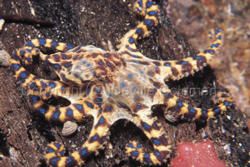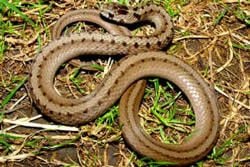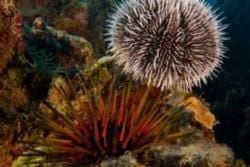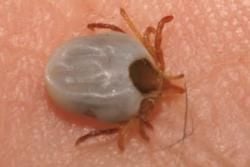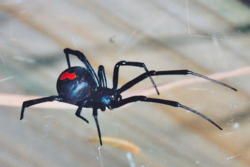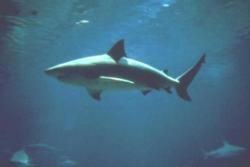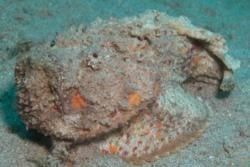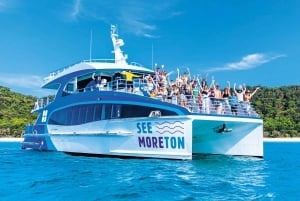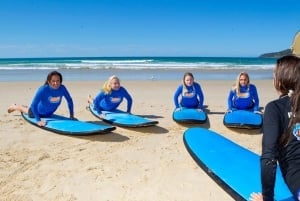Dangerous Animals and Creatures
Explore wildlife risks in Gold Coast
There are no dangerous animals in Australia, our hinterlands or rainforests so provided you do not get lost it is a relatively safe place. However there are dangerous creatures that you need to be aware of. The greatest danger you may face will probably be a shark, snake, spider or tick. However this is an extremely unlikely event unless you are reckless, act irresponsibly or just plain bad luck. Below is some basic information for you to keep in mind. The Australian emergency service is ( 000 ) triple zero, please remember this in case of an emergency. Basic Health and Safety information is also available here. The gold Coast is all about having fun so play safe, be responsible and enjoy.
Sharks:
Yes there are sharks in and around the waters of the Gold Coast. They can be found off our beaches, in the rivers, creeks, estuaries and ‘Broadwater’. And YES they are dangerous. However shark attacks are extremely rare since the instigation of the Shark Control Program by the Queensland Government in the 1960s. Sharks are now rarely sighted on open surf beaches (perhaps once every six months).
However, shark sightings in the canals are very common and since 2002 there have been two fatal shark attacks in canals and inland lakes. Our surf beaches are patrolled and of course one of the things the lifesavers patrol for, are Sharks! So be safe - swim at patrolled beaches and swimming areas and always swim between the flags.
Never swim alone, never swim at an unpatrolled beach, never swim if bleeding, and never swim at night. As an added precaution do not swim at dawn or dusk and above all, never swim in the rivers, canals or un-patrolled estuaries - unless you really do want to be attacked by a shark ! There have been approximately sixteen shark attacks on the Gold Coast since 1960 – the vast majority of them in canals, estuaries and lakes.
Other sea creatures:
These are other creatures that you may encounter in or near the waters of the Gold Coast. If you are planning a swim at the beach it is advisable to check the signs at the beach for any warning and be familiar with what you should do if you are stung or bitten by any of the following:
Bluebottle or Portuguese Man O 'War:
In Australia this jellyfish is known as the "blue bottle", due to its colour and shape. Elsewhere in the world it is known as the "Portuguese Man o War". The blue bottle is found on the surface of the ocean or washed up on the beach. The bladder remains at the surface, while the tentacles are submerged. The tentacles can be up to 10 metres in length. They have no means of propulsion; they are moved by a combination of winds, currents, and tides.
They can be found along the whole Eastern Australian Coastline. They are present when several days of strong onshore winds drive them into bays or onto beaches. It is rare for only a single blue bottle to be found as they are usually congregated by currents and winds into groups of thousands over a large area. Because of their sting they must always be treated with caution, and the discovery of large numbers of blue bottles washed up on a beach may lead to the closure of the whole beach. If you see them washed up on the beach don't pick them up or let your children touch them - they can give a very painful sting long after they are dead.
When the tentacle attaches itself to a human, it releases a poison and if you continue to rub the skin after the tentacle has been removed more poison or venom will be released. Stings usually cause severe pain and leave whip-like red welts on the skin which normally lasts about forty-five minutes after which it should subside. However the venom can travel to the lymph nodes and may cause more intense pain. A sting may also lead to an allergic reaction. There can also be serious effects, including fever, shock, and interference with heart and lung action. Medical attention may be necessary, especially where pain is intense or there is an extreme reaction.
The best treatment for a sting is considered to be:
(1) Avoid any further contact with the creature and carefully remove any remnants of the creature from the skin using an object (the idea is to not touch them directly with fingers or any other part of the skin to avoid secondary stings); protect hands with sand if there is no object handy.
(2) Apply salt water to the affected area. Note: fresh water tends to make the affected area worse!
(3) Follow up with hot water (45°C/113°F) to the affected area, which eases the pain of a sting by diluting the toxins.
(4) apply ice, preferably in the form of an icepack as this should be effective at suppressing any swelling and pain through reducing the activity of the toxins and reducing the sensation of the area of skin around the ice. Also ice constricts blood vessels, reducing the speed at which the venom travels to other parts of the body.
Blue Ringed Octopus:
These stunning but very deadly creatures live in our beautiful seaside rock pools which are full of wonderful, colourful delights and creatures. However these special and delightful rock pools are definitely a place of 'LOOK BUT DO NOT TOUCH'. One of the most deadly creatures to be found in them is - the 'Blue Ringed Octopus'.
The blue-ringed octopus is only about 12 to 20 cm (5 to 8 inches), but its venom is powerful enough to kill humans. There is no blue-ringed octopus anti venom available. Their bites are tiny and often painless, with many victims not realizing they have been bitten until breathing difficulties and paralysis start.
First aid treatment is to apply pressure on the wound and artificial respiration once the paralysis has disabled the victim's breathing muscles, which often occurs within minutes of being bitten. The bite often causes severe and total body paralysis but the victim remains conscious and alert. However the victim may not be able to breathe without artificial respiration. This will last some time but will eventually fade over a period of hours as the toxin is metabolized and excreted by the body. It is thus essential that rescue breathing be continued without pause until the paralysis subsides and the victim regains the ability to breathe on their own. This is a daunting physical challenge for a single individual so other artificial respirators and emergency help should be immediately called for. Hospital treatment is definitely required.
The symptoms vary in severity, with children being the most at risk because of their small body size. Because the venom primarily kills through paralysis, victims are frequently saved if artificial respiration is started and maintained until professional emergency medical help arrives. Victims who live through the first 24 hours generally go on to make a complete recovery.
It is essential that efforts continue even if the victim appears not to be responding. The toxic poisoning can result in the victim being fully aware of their surroundings but unable to breathe. Because of the paralysis that occurs they have no way of signalling for help or any way of indicating distress. Therefore respiratory treatment, together with calm reassurance, until medical assistance arrives is the best treatment and usually means that the victim will generally recover well.
Stone Fish:
Incredibly well disguised on the sea or ocean floor is the super toxic 'Stone Fish'. Stonefish are the most venomous of all fishes.
They can be found in the shallow waters of the bays, estuaries and reef flats of northern Australia as far south as the southern Gold Coast’s Tweed River. They live among or adjacent to aquatic plants, fallen trees, rocks and coral. The Stone Fish usually lies motionless, often partially burying itself in the surroundings and perfectly camouflaged itself amongst coral, rocky reefs, rubble, or aquatic plants. They can look like a rock and be difficult to move.
The stonefish has 13 sharp strong dorsal fin spines that are contained within a sheath of thick skin. At the base of each spine there are two venom glands that discharge their contents along ducts in the spine. When disturbed, the fish erects its spines, but maintains its position on the sea floor.
Stings usually occur to the feet of swimmers or waders who have not stood on clean sandy sea or water bottoms and have touched or stood on the sea floor closer to the more complex bottom sea beds or rock pools preferred by the Stone Fish. Multiple spines can often penetrate affected limbs, resulting in more extensive wounds. To prevent stonefish stings, sturdy protective footwear should be worn on reef flats, or while wading on soft-bottom sea beds, rock pools or adjacent to rocky or weedy areas. Anti venom for stonefish stings have been developed. In the event of a sting, the victim should leave the water, apply first aid and be prepared to commence immediate treatment as discussed for the Blue Ringed Octopus above. You should seek also urgent medical attention as soon as possible. The pain is immediate, excruciating and may last for many days. Muscular paralysis, breathing difficulties, shock, and sometimes heart failure and death can result.
Snakes: On land and in the water:
Snakes are common on the Gold Coast. The most common snakes that are seen are green tree snakes and carpet snakes. These two types of snakes are not venomous, but there are other snakes that are extremely venomous, the most common being the eastern brown which is very dangerous. There haven’t been a lot of attacks, but of course they do happen. Snakes can be present in the sand dunes of our beaches, golf courses, long grass and of course the bushlands and hinterland. They are also to be found on the banks of rivers, creeks, lakes and canal estuaries. They are prevalent from late August until late April. Be on the lookout especially with small children that may accidentally stand on one, or think the snake may be a stick. Snakes do like to lie in the sun so they are not always moving.
Snake identification is difficult. Colour seems an obvious feature but in many cases, colour patterns vary particularly with very dangerous snakes where individuals of the same species may be very different in colour and different species can be similar. So treat all snakes as if they are venomous, that way you can't go wrong. Umfortumately, most victims of snakebites are those who have tried to kill or interfere with them. The best advice is when you see a snake, leave it alone and walk the other way.
By being reasonably sensible you can avoid contact with snakes. Stay away from sand dunes, long grass (do you really need to find that lost golf ball?), step onto logs and not over them and look before you step down. Be conscious of where children are playing. If bush walking or in the rain forest wear long pants and shoes. Check boxes and storage containers left outside before putting your hands in. Be cautious around ponds and other small water areas.
Remember that the best response if you see a snake is to treat it as dangerous. Never, ever attempt to catch, trap or kill a snake. Nearly 100% of all snake bites occur because of people attempting to catch, trap or kill a snake. Remain calm and move as little as possible. Snakes do not hunt humans but they will vigorously defend themselves and strike if they are trapped, threatened or confronted. Remove children away from snakes as calmly and quickly as possible. Keep pets away and stay between children, pets and the snake. If you and those with you, stay calm, the snake will stay calm and be pleased when you go away !
The following are symptoms of a venomous snake bite:
Puncture marks,
Nausea, vomiting, diarrhoea,
Headache
Double or blurred vision
Breathing difficulties
Drowsiness or feeling giddy
Pain or tightness in chest or abdomen
Respitory weakness or arrest.
How to treat a snake bite (Treat ANY snake bite to be certain):
Stay calm and keep the victim calm.
Remove victim from danger
Try to remember what the snake looked like (take a photo if possible from a safe distance).
Do NOT wash or clean the bite
Apply a broad constrictive bandage starting at the bite site. (Use clothing if you have to).
Work towards the heart applying as much pressure as would be used with a sprained ankle.
Bandage as far up the limb as possible leaving the extremities exposed
Apply a splint to immobilise the affected limb. A straight stick will do.
If bite is to the head or heart attempt to apply pressure to effected area with a bandage.
Do not move the victim and use the limb as little as possible.
Note: do not wrap too tightly. Do not take off any wrapping until medical assistance advices it because the venom will spread very quickly once the wrapping is gone.
Spiders:
The Gold Coast has many varieties of spiders, the most dangerous being the ‘Red Back’ and the ‘Funnel Web’ spider, from which an untreated bite could be fatal. If you aren’t sure what sort a spider is, it is safer to assume that it is dangerous. Some of the spiders in the bushland and hinterland are very beautiful and make great photos. It is important though to remember to never aggravate a spider.
The ‘Funnel Web’ spider is an aggressive spider and active at night. As a general precaution do not leave clothing, especially swimming gear or shoes on the bathroom floor. Do not leave shoes or clothing outdoors overnight. Funnel webs are often found near or at the bottom of swimming pools where they can survive for several hours. Removal by hand from swimming pools has been the cause of some deaths in Sydney. If you spot a funnel shaped web in a hole in the ground or elswhere do not go poking at it.
The 'Red Back' spider pictured here is a very toxic spider and can cause death (although rarely) in some circumstances. This spider is not aggressive and bites only occur if you touch the spider. They are commonly found in discarded food tins or tin sheets on rubbish dumps, under benches or eves of buildings. They can also hide in shoes left out doors overnight.
The methods used to treat spider bites are the same as that described above for snake bite.
Australian Paralysis Tick:
There are many varieties of ticks on the Gold Coast but the tick of most concern is the 'Australian Paralysis Tick'. It is roughly confined to a 20-kilometre band that follows the eastern coastline of Australia. Encounters with these parasites can be relatively common and they are prevalent in the months August to February. Although most cases of tick bite are uneventful, some can result in muscle weakness, blurred vision, drowsiness, paralysis and even death by burying itself in a person's skin and injecting a neurotoxin. Children can be particularly susceptible to a tick bite.
Ticks are found in long grass, bushland and rainforest areas. If exploring these areas, trousers should be worn by everyone and tucked into socks and long-sleeved shirts into pants. An insect repellent containing DEET or Picaridin should be applied, with a cream repellent applied to the skin and a spray repellent to footwear and clothing (that's because DEET can damage some synthetic clothing). Remember to reapply the repellent every few hours.
Ticks are difficult to detect and symptoms include, itchiness, loss of appetite, weakness, shortness of breath, vomiting and numbness. These reactions can take time to develop and even a day or so. As a precaution on your return home, remove all clothing and place into a hot dryer for 20 minutes to kill any ticks that may still be on your clothes. This is important because ticks can wander on the body for up to two hours before attaching themselves to you. Check the whole family especially children thoroughly for ticks, especially behind the ears, on the back of the head, the groin, armpits, and back of the knees. Because ticks are sometimes hidden by swelling around the bite, it's important to check any lumps carefully.
If you find a tick the best way to remove an attached tick is to use tweezers with a fine point. Grasp the tick behind the head as close to the skin as possible. Gently pull the tick straight out using steady pressure. Don't try to kill the tick before removal by using methylated spirits, alcohol or anything else as this can make the tick inject more poison. After removing the tick, wash your hands and disinfect the tweezers and the bite. If you have trouble, seek medical help and have the tick surgically removed. Seek medical attention for allergic reactions or unusual symptoms.
Your Gold Coast local experts have lived on the Gold Coast for many years and had enjoyed many family holidays before that ! They have never encountered any of the above creatures except for the occasional sightings. Be sensible, know the dangers and have fun.


